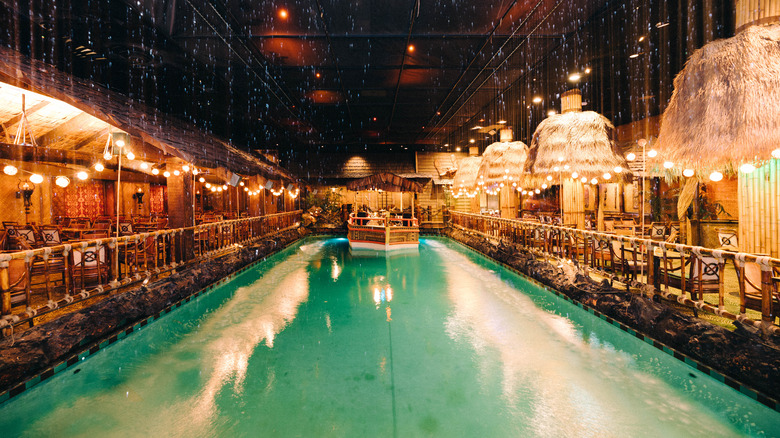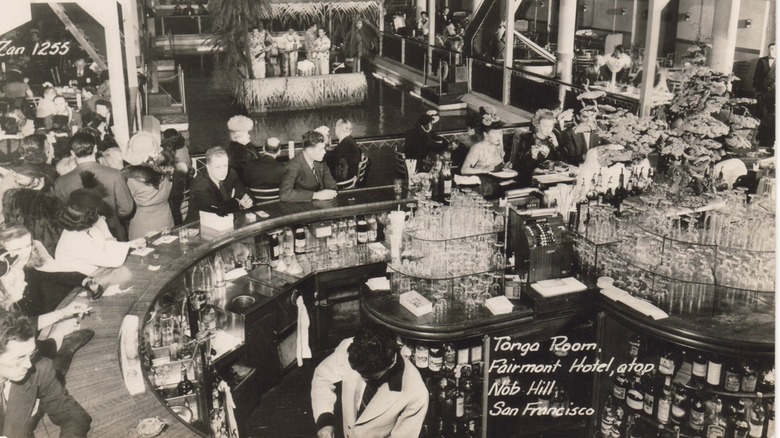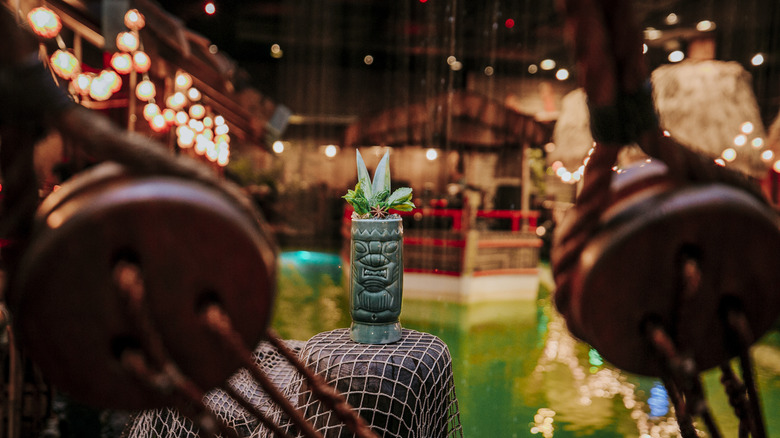At San Francisco's Tonga Room You Can Sip Cocktails Around A Swimming Pool Turned Tiki Bar
What's the first thing that comes to mind when you see the words "tiki bar"? A fruity umbrella drink served in a hollowed-out pineapple? A dashboard hula doll? A rainbow of hanging paper lanterns? To be fair, there's a lot of kitsch inherent in tiki décor, but there's a lot of history, too. Consider San Francisco's Tonga Room & Hurricane Bar. Located at the Fairmont San Francisco in the City by the Bay's iconic Nob Hill neighborhood, the Tonga Room & Hurricane Bar is a longtime mainstay that remains popular among visitors and locals alike. At first glance, it may appear to be a typical, albeit somewhat refined, version of a classic tiki bar, but there's more to the Tonga Room than meets the eye — at least when you know where to look.
Prior to the debut of the Tonga Room in 1945, a swanky indoor swimming pool occupied the space. Known as the Fairmont Terrace Plunge, the 75-foot pool opened in 1929 — a first for San Francisco — and quickly earned a following among the city's movers and shakers of the day. But by the mid-1940s, interest was waning. So what's a luxury hotel to do with a rarely used indoor swimming pool? Turn it into a tiki bar, of course. It was a challenging task to be sure, but the powers-that-be at Fairmont San Francisco — the flagship property of the still-prominent hotel brand — were confident enough in their vision to call on Hollywood for design advice.
Tiki culture took off post WWII
Mel Melvin, a set designer for Metro-Goldwyn-Meyer, stepped up to the task, transforming the pool into a lagoon surrounded by nautical décor. The new venue opened in 1945 as the S.S. Tonga, but a name change to the Tonga Room, accompanied by a shift to a mid-century tiki-bar vibe, followed soon thereafter. Along the way, authentic artifacts reportedly salvaged from the S.S. Forester, a four-masted schooner that plied trade routes between the U.S. West Coast and the South Sea Islands in the early 20th century, became part of the décor — and still hold pride of place. Masts and rigging adorn the walls, and the dance floor is made from reclaimed lumber.
The project cost Fairmont $75,000 (about $1.25 million in 2023 dollars), but the investment proved its worth. The timing couldn't have been better. Spurred by the interest of World War II veterans returning from the South Pacific, tiki culture was experiencing a heyday. The Tonga Room, with its albeit kitschy interpretation of the theme, was a hit. A thatch-covered barge floating in the swimming pool-turned-lagoon became the stage for live music performances. Patrons sipped on oversized cocktails with a tropical twist, occasionally indulging in one too many and engaging in scandalous hijinks. According to a 2019 article in Imbibe, Pulitzer Prize-winning journalist Herb Caen reported in a 1946 article for the San Francisco Chronicle, "Well, it finally happened; a couple of spifflicated gents stripped down to their shorts in the F'mont's Tonga Room the other night and leaped into the swimming pool!"
It's all about décor and cocktails
A dramatic thunder-and-lightning element added in the 1950s, followed by a 1967 upgrade by mid-century "it" designer Howard Hirsch, kept the vibe going well into the 1990s — but tastes changed, and fruity tiki drinks took a hit. Fairmont did a $1 million renovation in 2008, but a year later, the brand was considering demolishing the iconic space to make way for condominiums.
But locals mobilized to save the Tonga Room, and Fairmont tabled the redevelopment plans. Then, Anthony Bourdain stopped by. The late chef, author, and television personality was filming a 2012 episode of "The Layover" for the Travel Channel when he visited the Tonga Room with San Francisco chef Chris Cosentino. Awestruck, Bourdain declared, "The indoor rain showers and thunder — awesome, right? The stage that floats over the pool just waiting for, like, Don Ho to sing 'Tiny Bubbles.' This is the greatest place in the history of the world."
If the line out the door is any indication, Bourdain's observations were spot on. San Francisco lifestyle vlogger Rose Catherine, a self-proclaimed early-bird diner, arrived 15 minutes before opening and still had to wait for a table. (With few exceptions, there's a no-reservations policy.) While the vlogger and her dining companions loved the tiki vibe, they were less impressed with the food. A quick scan of online reviews shows that seems to be the general consensus. By most accounts, the Tonga Room serves standard Asian-American fare: good but not exceptional. The décor, cocktails, and experience are the main attractions.


